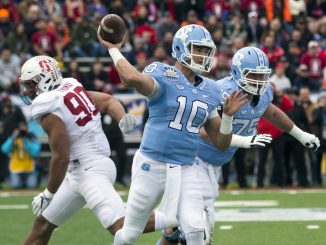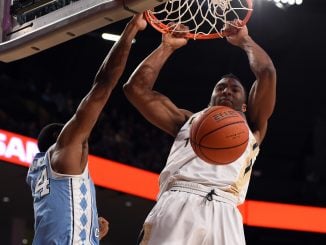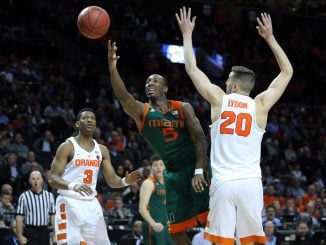RALEIGH Hannah Aspden still remembers her first paralympic meet.She arrived alongside her parents for the three-day meet at the University of Minnesota in 2011. A natural swimmer since she was four years old, Hannah had plenty of experience in the pool, but the US Paralympics Spring Swimming Nationals was unlike anything else the 10-year-old had ever experienced.There were limbs strewn everywhere, prosthetic legs cast by the wayside as their owners shed their plastic appendages for races where they wouldn’t be needed.Wide-eyed and full of nerves, the Raleigh native walked across the deck with the help of her ever-present crutches. It was all going well until she hit a slick patch on the pool deck and tumbled to the ground.That could’ve ended everything. She could’ve given up and sulked away in embarrassment. As she’s learned to do so often in her life, Hannah got back up, shook it off and fought through it.”That’s what I remember from the beginning of that,” said Hannah, who was born without her left leg. “Everything from there was awesome. Just get the nerves out by face planting and then you’ll be fine.”Six years later, Hannah is preparing for her biggest meet yet: the 2016 Rio Paralympics. Eight months ago, a simple trip up the stairs in her home was difficult. And Rio? That felt impossible. ⢠⢠â¢During the coldest winter months, Hannah shocked her parents by wearing shorts and a t-shirt to and from swim practice, but in November 2015, she shivered under layers of sweatshirts, sweatpants and socks inside their heated Raleigh home.Her blood pressure spiked, she got sick after she ate, she periodically lost feeling in her hands and feet, she couldn’t regulate her body’s temperature, and she alternated between bouts of dizziness and shaking.Something was wrong, but nobody could explain it.How could a perfectly healthy 16-year-old suddenly have health problems found more commonly in people three times her age?It was inexplicable.But after two trips to the emergency room and countless trips to nearly every specialist at Duke, the Aspden family finally had a diagnosis: dysautonomia an umbrella term for an autoimmune disorder that causes the body systems to go haywire. In Hannah’s case, there’s no sure way to tell what triggered it. The doctors’ best guess is that it was a response to a bad respiratory virus Hannah had two weeks before Thanksgiving. And as she was recovering from the virus, the mysterious disease rapidly evolved.”We’re lucky to live near Duke,” Hannah’s mother, Jennifer said. “We’ve seen about every -ologist at Duke trying to go through it. The first thing, other than being sick, we went to her pediatrician and her blood pressure was really high and we were like, she’s in great physical shape, this should not be happening. She’s still on high blood pressure medicine. Some days she couldn’t even climb up the stairs. All of a sudden it just wiped her out.”It’s not all that uncommon, the Aspden family learned. More than 70 million people live with the disease all over the world. But while the disease doesn’t have a specific cure, there are ways to manage it, and eventually, the symptoms fade but that can take months or even years.Hannah had to learn to manage her symptoms and not overexert her body as the autoimmune disease ran its course. It was a total loss of control, an unfathomable sentence for someone who’s thrived in pushing herself beyond the expected limits since she was born.⢠⢠â¢The disorder kept Hannah out of the pool for just a few weeks, but it felt like a lifetime for the girl who fell in love with swimming at the age of four.Following in the footsteps of her older brother, Hannah not only wanted to learn to swim, she wanted to break boundaries she craved the coveted black band allowing her entrance into the deep end. It wasn’t long before she earned the all-access pass to the YMCA pool. A day later came the next milestone: the diving board at her neighborhood pool.For Hannah, swimming was more than a hobby it was a place where disabilities didn’t matter.”I remember trying basketball and trying soccer, and they were fun, but swimming has always been my favorite,” Hannah said. “I’ve always liked that it was easier for me to compete against the two-legged kids.”By the time she was eight, Hannah was swimming competitively year-round with the YMCA of the Triangle Area. Two years later, she was entering international paralympic competitions and was named to the US Emerging Team roster at 12 and to the National Team roster at 13. She’s been to meets around the country and a handful of international meets, including the 2015 IPC Swimming World Championships in Scotland where she earned a silver medal in the 4x100m freestyle relay.While the freestyle and backstroke specialist doesn’t really have to modify her stroke, there are aspects of her sport that require a little tweaking. Swimsuits are made with two leg holes, but because she has no use for one of them, Hannah has to have them specially made.So after her daughter picks out a suit, Jennifer heads to the fabric store to get extra material and then drops everything off at the tailor to sew up the extra opening.Though she was undersized at birth and arrived without a leg likely the result of a blood clot in utero there’s no doubt Hannah was built to be a swimmer. At 5-10, she is physically more mature than most 16 year olds. Her muscular shoulders flow into arms made even more powerful through the everyday use of her crutches. And that lack of a leg? Barely noticeable when she’s in the water.”I first saw her when she was swimming, I had never even seen her on deck,” said Matt McInnis, one of Hannah’s YOTA coaches. “She was a very strong swimmer from the get-go. I honestly didn’t even see that she was handicapped. She was swimming like she had two legs and she was keeping up with the best of them. I didn’t think anything of it.”She hopped out of the pool and I was quite shocked. But from the get-go, I could see that she had a lot of strength and a lot of competitiveness. Other than that, she was just another swimmer.”⢠⢠â¢Through the early months of her illness, there wasn’t much Hannah could do at full strength. Her life seemed to move in slow motion as she coped with the autoimmune disease. Along with missing time in the water, Hannah also missed seven weeks of school.”At first when this all started I was kind of just worried about a lot of things, swimming was one of them,” Hannah said. “I was trying to figure out, when am I going to be able to get back in the water? When am I going to go back to practice? I didn’t get to go to one or two meets that we had scheduled. I had to back out of those just because I couldn’t get in the water at practice.”How was I supposed to go do a meet and race? I didn’t race for six months, which was really hard mentally, being away from that big of a part of my life before this for so long. I definitely was worried about how I was going to come back with this.”Before Hannah got sick, she was training at full speed, hoping to make Paralympic Worlds for the second time. Suddenly, she didn’t even have the strength to get in the pool.As a mom, Jennifer thought about telling her daughter to take the year off, but Hannah wanted to keep swimming.When Hannah was finally able to resume some physical activity, Jennifer brought a blood pressure monitor to the pool. She sat a couple of feet away while Hannah swam a 50 a fraction of her usual workouts. And when her daughter finished laboring through the set, Jennifer knelt down beside the pool and checked her daughter’s blood pressure.Often in the early weeks of her return, Hannah’s blood pressure would be dangerously high after just the brief time in the water. Slowly, she’d get out of the pool, sit on the bench to calm her body down, and then walk to the car with her mom.In March, Hannah resumed training with her regular groups. But she still couldn’t participate fully in their workouts and continued to go at her own pace, modifying her practices to her body’s capabilities that changed on any given day.”Getting back was really hard, it took me a half hour to do a 500,” Hannah said. “I just couldn’t do anymore. It started out pretty bad and hit pretty hard. It very slowly started getting better and some symptoms will come and go and there’s so many ups and downs. It’s very unpredictable, but overall it’s gotten so much better than it was.”While some athletes spend years mentally and physically preparing for the Paralympics, Hannah had just two months of team training before the June trials. Her illness kept her out of Worlds and other major meets usually used as tuneups, but she managed to squeeze in two meets in May, traveling to the Cincinnati Para-Swimming Open and the Arena Pro Swim Series meet in Charlotte.And even with limited training, Hannah flourished in those meets, capturing five first-place finishes in the Cincinnati Para-Swimming Open.But Hannah was still nervous entering the Paralympic Trials. Was her body ready? Would her disorder flare up again and derail her Rio hopes? Would she be fast enough?Hannah quickly quelled those fears, turning in a first-place finish in her signature 100-meter backstroke race while also improving on some of her times from the previous meets.And when the names for the US team headed to Rio were announced at the conclusion of the meet, Hannah was the first name called perks of alphabetical superiority.”The good thing is I didn’t have to wait too long,” Hannah said. “I think I was the first name on the whole list. She was like, âAlright I’m going to read the names’ and she read my name and I was like âWhew, OK good, good, I can breathe now.’ I didn’t have to wait so long.”Her training still isn’t back to 100 percent, but she’s pushing herself as hard as she can with the help of a rotating cast of coaches and teammates. During most of the year, Hannah trains with YOTA. But when the that team went on its annual hiatus in late July, Hannah worked with her coaches individually to get daily workouts six days a week. And sometimes, her YOTA teammates joined her at the pool as surprise workout partners.”It’s been rough, but she’s really strong,” Jennifer said. “She’s had some really, really rough days. But she stuck with it and just made the best of each day and she always, there’s been very few days that she let it tear her down. She’s always had a great attitude about everything and not just swimming, school too. That’s the hard thing, she doesn’t want to let anything slip. So even her school, she wasn’t going to not do her hardest to get As in everything. I’m like, âIt’s OK! People will understand.’ But she’s a perfectionist in everything that she does. I’m really proud of her.”She’s really fought hard for everything to be where she is right now. She’ll be proud of that no matter what the outcome. You can only do what you can do and what your body can do. She’s going to give it her best.”⢠⢠â¢Eight months after her diagnosis, Hannah and her mom are sitting in a restaurant about a mile from where she trains at the A.E. Finley YMCA. Her long blonde hair is loose and she’s wearing a gray USA t-shirt. In a few short weeks, she’ll be decked out in even more USA gear, nearly 5,000 miles away from home as she marches in the Paralympic opening ceremonies.”I got an email the other day it was like just confirmation that you’ll be at the opening ceremonies,” Hannah said. “It was like, âOh yeah, I’d like to be there!'”She’s excited about the trip less excited about the travel to get there but she’s brimming with joy as she talks about the upcoming Paralympic experience. And of course, part of that Paralympic experience is understanding how she got there.In telling her story, Hannah doesn’t sugarcoat anything. She’s naturally modest and soft-spoken, but through her ordeal, she’s become more thoughtful and pensive than most 16 year olds. She knows she’s lucky. She knows it could’ve been a lot worse. And she knows that fighting for her health has given her a greater life perspective than most people, let alone teenagers, will ever achieve.”I am actually proud of how far I’ve come in the past several months because it’s been really rough, to say the least,” she said, tears welling up. “And I had no idea that I would be where I am today eight months ago.”
Related Articles

Sports
UNC stands to benefit if Trubisky picked No. 1
Although it’s not as certain as it seemed earlier in the day, there’s still a chance that North Carolina quarterback Mitch Trubisky will be the first player selected in the NFL draft tonight. The benefits […]

Sports
Georgia Tech stuns UNC in ACC hoop opener
ATLANTA — After freshman Josh Okogie scored only five points in a near loss to North Carolina A&T in Georgia Tech’s previous game, Yellow Jackets coach Josh Pastner had a heart-to-heart talk with Okogie. The […]

Sports
Miami poses difficult first ACC tourney test for UNC
BROOKLYN, N.Y. — North Carolina didn’t have the luxury of hand-picking its opponent in the first round of the ACC tournament. Miami and Syracuse played for that distinction on Tuesday. If the Tar Heels had […]
